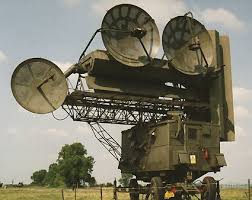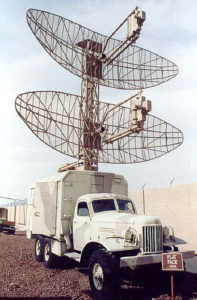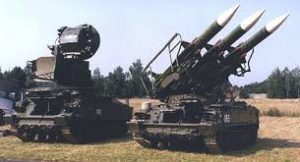Sometime during the 1970s the AIL EMR ELINT system was to be replaced with the EIP (ELINT Improvement Program). This added another dimension to the accuracy with an Azimuth/Elevation system replacing the Azimuth only system of the EMR. The EIP antenna arrays were a ‘double dual’ spiral configuration. I think the configuration came from work done by Bob Goodwin during his time at AIL. I remember that Len Kuskowski worked on the upgrade. Included in the upgrade were improved recording/playback system and a data pre-formatter. The data format was changed requiring completely new processing and the CDC computers had been replaced by smaller, faster SEL computers. The EMR processing was being migrated to SEL computers at AIL, Deer Park, NY.
During the testing of the EIP system at Beale, John Speth, Tom Brown and I began processing the EIP data at the pulse level to assist the field shop in testing of the new system. The EIP processing software was to be completely new and being written to accommodate ‘real time’ processing if a downlink ever became available on the SR71. The software was being done in a group headed by Cynthia Cousins.
With not much to do, John, Tom and I began to modify the EMR processing software to process the EIP data. This was initially done to get familiar with the formats and to assist the field shop in further trouble shooting. This was quite a task since the basic format of the pulse level data was very different. In addition, the recorded data on the EIP recorder also included navigation data. We did not have to depend on getting navigation data from the Mission Recorder System (MRS) data processers.
John, Tom and I set up shop on the ground floor of the SAGE building at Beale in the area where Houston Fearless was busy modifying mobile processing vans, including ones for EIP processing. To add to the complexity, the original CDC 3200 computers were being replaced with SEL 32/75 computers. A benefit was that we got away from using IBM punch cards to write the programs.
I directed the programming effort of this small group and it wasn’t too long before we had modified the EMR batch processing software to a point where we could completely process the EIP data to the report level including locating and identifying the signals. We had also written quite a few analysis routines to check the processing at different points in the processing. We had been using this software for about one month and the Air Force analysts were getting familiar with the vastly improved accuracy of the EIP. The added benefit was that the evaluation of the EIP was easier than just looking at raw pulse level data. Everyone in the ELINT analysis shop was aware that we were able to completely process the EIP data to the report level.
 During one of the test flights over an emitter range located in the US, the EIP fixed and located all the emitters that had been coordinated for the test. While processing and evaluating the data there were several emitters that were identified and located that were not on the list of coordinated emitters and were over 100 miles from the flight path. We also included these in our evaluation report.
During one of the test flights over an emitter range located in the US, the EIP fixed and located all the emitters that had been coordinated for the test. While processing and evaluating the data there were several emitters that were identified and located that were not on the list of coordinated emitters and were over 100 miles from the flight path. We also included these in our evaluation report.  Several days later we had a visitor from somewhere with clearances that wanted to look at our data and especially at the uncoordinated emitter data. After agreeing that the EIP had done a superior job of identification and location he confiscated the data and went back to wherever he came. I don’t think the existence of those emitters was supposed to be known.
Several days later we had a visitor from somewhere with clearances that wanted to look at our data and especially at the uncoordinated emitter data. After agreeing that the EIP had done a superior job of identification and location he confiscated the data and went back to wherever he came. I don’t think the existence of those emitters was supposed to be known.  They were not of US origin. However, it did prove that the EIP on the SR71 had the ability to ID and locate at a range far greater than any other air breathing collector.
They were not of US origin. However, it did prove that the EIP on the SR71 had the ability to ID and locate at a range far greater than any other air breathing collector.
One morning I got a call from LtCol Don Raymond, in the Pentagon. I had known Don since his days in the INTEL vault on the third floor of the SAGE building. He had just become the Program Element Monitor (PEM) for the SR program. Don asked me if we could process the new EIP data and how good was it. The answers I gave him were ‘Yes’ and ‘Very Good’. I explained how we were doing it and that the testing of the EIP was going well.
About a half hour later an AF officer (can’t remember his name) came running back to the analysis area looking for me. He wanted to know what I had told Don Raymond. He was a little pissed because he had told Don several hours previous that since the EIP software had not been delivered from AIL that we could not completely process the data. He was supposed to be the local AF expert on it but was not aware of what was really going on. After I told him of my conversation with Don and he had simmered down and talked with several of the AF analysts, he agreed that we were indeed processing the data to the report level. He asked what I was going to be doing next week and whatever it was it would include going to England to process the EIP ELINT data. The original plan was to not send the EIP system on this deployment but that quickly changed, and I spent the next several weeks at Mildenhall.
As I recall, the first EIP trip to England was for the SR71 to fly some operational sorties while the Warsaw Pact countries were playing war games.  The games would involve the deployment of equipment from storage yards, including radar and early warning systems to support the exercise. The AF was determined to find out where the preferred SAM sites were located.
The games would involve the deployment of equipment from storage yards, including radar and early warning systems to support the exercise. The AF was determined to find out where the preferred SAM sites were located.
By that time the 9th had a complete Mobile Processing Center (MPC) in vans for deployment. The complete unit was flown to Mildenhall and set up in a large hanger. There were several portable buildings in the hanger used for offices and a adjacent area where the vans were set up. This was late in the year and the hanger was very cold. Going outside the vans or the office space and into the hanger proper was a shock to the system. To make matters worse, the restrooms were not located in any warm area.
The Colonel in charge was Lonnie Liss. I think he was the vice wing commander of the 9th. LtCol Don Raymond was also present. The Colonel was a little apprehensive about the processing of the EIP data with non-sanctioned, field written software and expressed that to me.
He asked that he be the first one told if there were any problems. I replied that if any problems arose and I could not solve it within a 30 min he would be the second know. We had no problems during the deployment and the INTEL community was delighted with the reports.
This first EIP deployment was over the Christmas holidays. Col Liss, LtCol Raymond and I had Christmas dinner at the Bull in Barton Mills. About the only thing I remember of the meal was the roast beef, the scotch and the dessert tray with all sorts of chocolate cakes on it. We took about 2 hours to enjoy the meal.
The outcome of this was that once back at Beale the AIL EIP software began to arrive. The processing we had developed in the field was not ‘real time’ but was almost a fast when the missions were played back from the collection tapes. Since there was never a data link put on the SR71 there was no way to do a real ‘real time’ check of processing speed. However, the field developed software was used as the evaluation tool against which the ‘sanctioned’ software was measured. Tom, John and I had done a real good job.
When the SR71 was finally deployed to England on a permanent basis, Tom Brown became the site AIL ELINT expert and was able to handle any changes we sent to him for minor upgrades. Bob Putland and Greg Novak were two of the AIL EIP maintainers in the field shop. When major software upgrades were released I would usually go to the overseas locations for install and checkout and a little training.
During the TDYs to England most of the temporary AILers would stay at homes of the British folks around the Base. On one of the trips I was staying at the home of Dave and Pat Cook in the little village of Fornham St Genevieve near Bury St Edmunds about 20 miles from Mildenhall. During the winter months the biggest problem of driving at night was fog and black Ice.
The ELINT processing and reporting would usually end sometime around midnight and driving all the way back to Dave’s was not that enjoyable. One Friday night I was going about 30mph and hit some black ice and ran it the end of a stone wall on the road through the village of Icklingham. No injury, but the rental car was not drivable. I did call the rental agency about midnight and the manager came out to give me a ride to Dave’s. I had a hard time getting him to believe my story, but he finally did.
The following Monday Pat Cook drove me to the rental agency to get another car. They were a little cautious about renting to me but finally gave me a rather small car. I was driving to work about 15 minutes later and got stuck at a ’roundabout’ near the base. I looked in my rear-view mirror to see a woman with a child in a car seat paying more attention to the kid than the line of cars ahead and she tried to stop but rear ended me. No one was injured but her car was inoperable. So, I put her and her child in my car and drove directly back to the rental office with solid proof that it wasn’t my fault. This time they gave me a ride to work because they did not want to rent me the nice new Volvo they had but would get me another car by that afternoon.
I went to lunch that day at the O’Club and rented a room for time I would still be in England. I paid for it out of my own pocket, so I would have a safe place to go to when fog or black ice was a problem. Several times when there would be a SR71 crew rotation and there were no rooms available I would give my room key to one of the crew members for the night and slowly drive to Dave’s.
On one of the crew change occasions, LtCol Don Emmons (later Colonel and SR71 project head at Norton), LtCol Lee Shelton (later Colonel and Okinawa Detachment Commander at Okinawa) and I were having a few beers at the O’Club stag bar. We decided to go the Marauder Pizza house on base and order one and bring it back to Lee’s room with a six pack for dinner. Don ordered a Jalapeno Pizza and while putting some additional hot pepper flakes on it, the top of the hot pepper shaker fell off and the container emptied onto the Pizza. Don brushed what he could off, and we went back to Lee’s room. I don’t ever remember drinking beer so fast. The jalapenos and the addition of the hot pepper made for an interesting meal. The next day was also interesting, even to the point of sitting down.
